Menus
- What can the BMW super sports car do?
- Technical specifications
- Technology news
- Measurements
- Conclusion
- Rating engine
- Rating chassis
- Evaluation of everyday life
- Security rating
- Valuation costs
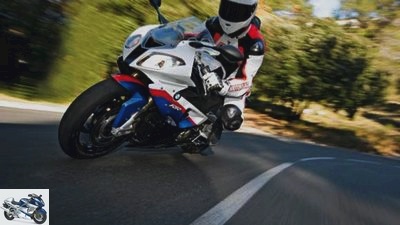
Artist
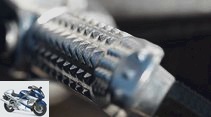
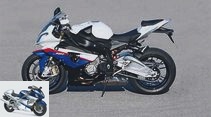
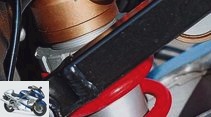
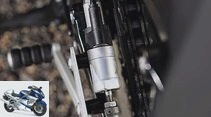
13 photos
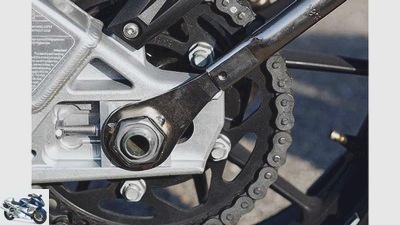
Artist
1/13
The on-board tool kit of the BMW almost ties in with old traditions. With the help of the nine-piece set, you can strip the motorcycle, tension the chain, replace defective lamps and fuses, and adjust the spring preload front and rear.
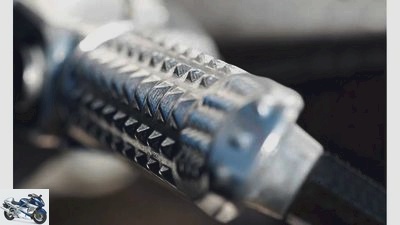
Artist
2/13
The footrests are serrated so that the driver’s boots find a secure hold for all gymnastics exercises that are relevant to fast driving.
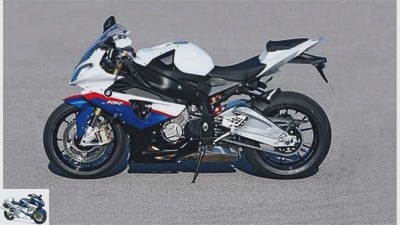
Artist
3/13
A lot of carbon and a delicate shape mean that the S 1000 RR has almost 1 hp per kilogram when fully fueled.
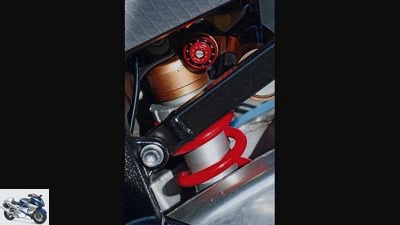
Artist
4/13
The rear compression level can be set in low and high-speed damping.
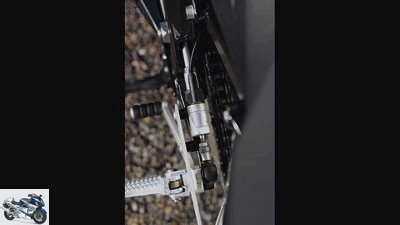
Artist
5/13
Shift up at lightning speed at full throttle: the shift assistant for 360 euros makes it possible.
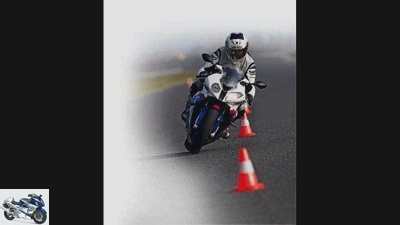
Artist
6/13
Fast as an arrow: the S 1000 RR in the forest of pylons on the top test course.

Artist
7/13
If you want, you can switch off ABS and DTC. The testers didn’t want to, but switched modes more often.
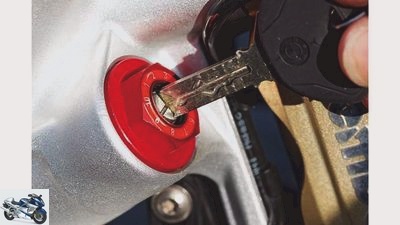
Artist
8/13
The ignition key fits into the heads of the adjusting screws on the fork and the low-speed compression stage of the shock absorber. Most of the damping functions can be quickly adapted to different circumstances.
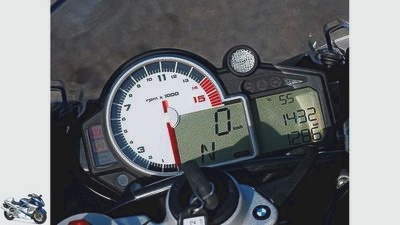
Artist
9/13
What you need: a large rev counter and shift light for the racetrack, useful displays for the country road.
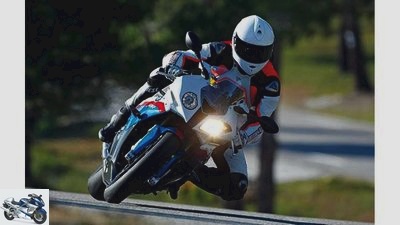
Artist
10/13
The S 1000 is characterized by pleasant handling, high driving stability and steering precision.
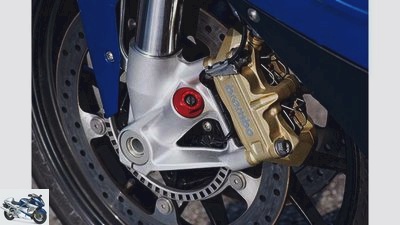
Artist
11/13
The radially screwed Brembo pliers are not monoblocs, but they bite powerfully and easily.
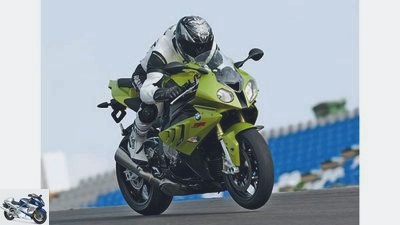
BMW
12/13
The prevention of violent wheelies or stoppies, also a function of the DTC, happens independently of the gyro sensors.
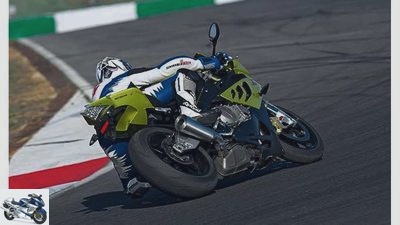
BMW
13/13
Lean and fire free. Everything else is done by the DTC. You just shouldn’t fall over the front wheel when entering the corner.
Top test BMW S 1000 RR
What can the BMW super sports car do?
BMW has built a strong super sports car. Hardly anyone expected that it would soon become the strongest production machine ever measured by MOTORRAD. The S 1000 RR also proves to be a well-balanced overall system.
Ten dyno runs, ten times infernal noise, glowing exhaust manifolds, the dyno roll howls at a painful height. The results are sensational: the MOTORRAD test machine pushes between 199 and 202 hp. Speechless amazement among the testers. This is followed by suspicion, cross-checking and confirmation: the specimen measured for comparison by a private customer, having barely retracted 400 kilometers, generated 196 hp; the measurements published by the renowned exhaust manufacturer Akrapovic also show around 200 hp for the S 1000 RR.
Buy complete article
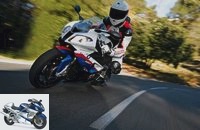
Top test BMW S 1000 RR
What can the BMW super sports car do?
S 1000 RR properly closed. Then the performance curve begins after a minimally short behavior – the torque here is 100 Nm – its grandiose final increase. Only 5000 rpm later does it reach the summit. And the accelerating S 1000 RR feels exactly what the bend looks like. It pulls up without any noticeable break-ins, the driver feels the relentless development of power at high engine speeds long before he unleashes it. In this way, the BMW can be wound up on the edge of the acceleration wheel with an intoxicating four-cylinder roar. madness!
If the front wheel snaps upwards surprisingly violently, the electronics (an additional function of the traction control DTC, which is subject to a surcharge) intervene somewhat harshly but reliably. In slick mode, the fourth and hottest driving program, which can only be activated after inserting an additional plug into the control unit, it allows longer wheelies. The result of the cooperation between power and electronics: brilliant acceleration from zero to 200 km / h in the best time in its class of 7.0 seconds. Compared to all the other four-cylinder super sports cars, which are a maximum of three tenths of a second apart, the BMW makes 0.5 to 0.8 seconds here. Do you notice these differences while driving? Oh yes, and how clearly. Long before the measured values were fixed, the testers experienced the acceleration power of the BMW with initially incredulous astonishment, then deeply felt admiration. They then only spoke in incomplete sentences: "So what she does to you…"
Bosch
The sensors that transmit their signals to the central control unit are located in this Bosch box.
Rain, Sport, Race and the aforementioned slick mode control the response of the engine, traction control and the work of the ABS. Except in the rain mode, which does not allow more than 150 hp, the full power is retained.
The price for the high-performance characteristics of the S 1000 RR and the associated higher speed level has to be paid at the petrol station. Exactly six liters per 100 kilometers of moderate country roads are evidence of rustic drinking habits. During the test drives in the south of France, however, it was quite cool and the air was accordingly rich in oxygen, so that the proportion of fuel was also more abundant. It is quite possible that the BMW will need a little less in warm summer weather. Thanks to its 17.5 liter capacity, it can travel 292 kilometers before the tank dries up, in practice that is enough for a decent 250 kilometers, after about 220 kilometers a warning light warns.
The cool weather and occasional rain during the test drives made the traction control work time and time again. In turn, it made the drivers feel good. Especially since the homogeneous, but not exactly bad weather, Metzeler Racetec K3 Interact could never actually be brought up to operating temperature on country roads. Whether it was a damp spot, an agricultural legacy, the little slide over the edge of a frost breakout or just the joyful exuberance of the testers that brought the rear wheel off track, the DTC (Dynamic Traction Control) always regulated the performance quickly and discreetly back. It proved itself not only when driving on the racetrack, but also in everyday use. MOTORRAD therefore warmly recommends spending the 1220 euros on the combination of DTC and ABS. The ABS alone already costs 915 euros.
Artist
If you want, you can switch off ABS and DTC. The testers didn’t want to, but switched modes more often.
DTC and ABS cooperate with each other; Depending on the driving program, they regulate the engine and braking power in different proximity to the limit. In rain, sport and race mode, in which the traction control as well as the wheelie and stoppie limitation work rather conservatively, the S 1000 RR stably achieves a deceleration of 9.3 m / s2 over numerous attempts. The slick mode, which allows the rear wheel to lift off and in extreme cases does not prevent a rollover, allows a little more. The control behavior of the ABS is more of a shirt-sleeved design. The control processes cause strong deceleration fluctuations in every mode and can be clearly felt in the lever. It takes some training and effort to keep the lever pulled consistently.
Artist
The S 1000 is characterized by pleasant handling, high driving stability and steering precision.
Thanks to high-quality components, the brake can also be carefully adjusted by the driver himself. He is fully responsible for braking while turning in anyway. Those who act too cocky will fall – as before. ABS and DTC intervene in the limit area. However, you cannot override it if it is run over too hard. You are still well advised to turn off the gas automatically and evade if there is an oil stain at the exit of a curve.
If the brakes and clutch of the S 1000 RR are pleasantly easy to operate, the sluggish throttle grip, the resinous gearshift and the somewhat tough steering have to be criticized. The one that bothers the least and is no longer noticeable beyond 30 km / h. Despite its comparatively long wheelbase, the Supersport BMW can shine with carefree maneuverability that it maintains even at higher speeds. It completed the fast slalom of the top test course almost as fast as the Aprilia RSV4, the speed of over 120 km / h is even sensational.
Artist
Fast as an arrow: the S 1000 RR in the forest of pylons on the top test course.
Just imagine how you fold your motorcycle from one lean angle to the other with violent tearing of the handlebars, supported by a little swing of your hips between tightly set pylons. Without the fork and shock absorber causing uncontrollable steering reactions by snapping rebound or otherwise creating uncertainty. The spring elements were in the standard setting; they turned out to be mechanically smooth, but dampened rather tightly. This leaves plenty of reserves for hotter days and rides. Applied to the autobahn, country road and race track, this means that the S 1000 RR offers a high level of active safety.
And that forms a solid basis for a wide range of sporty driving. Because the driver doesn’t have to duck extremely on the handlebars, it is a lot of fun even on winding streets. Although, like all of her competitors, she actually belongs on the racetrack, she does not move outside of normal traffic reality.
Technical specifications
Artist
The setup that was used for the test with the BMW.
Engine:
Water-cooled four-cylinder four-stroke in-line engine, two overhead, chain-driven camshafts, four valves per cylinder, rocker arms, wet sump lubrication, injection Ø 48 mm, regulated catalytic converter, alternator 434 W, battery 12 V / 10 Ah, mechanically operated multi-plate oil bath clutch, (anti- Hopping), six-speed gearbox, chain, secondary ratio 44:17.
Bore x stroke 80.0 x 49.7 mm
Displacement 999 cm³
Compression ratio 13.0: 1
rated capacity 142.0 kW (193 hp) at 13,000 rpm
Max. Torque 112 Nm at 9750 rpm
Landing gear:
Bridge frame made of aluminum, upside-down fork, Ø 46 mm, adjustable spring base, rebound and compression damping, steering damper, two-arm swing arm made of aluminum, central spring strut with lever system, adjustable spring base, rebound and compression damping, double disc brake at the front, Ø 320 mm, four-piston fixed calipers , Rear disc brake, Ø 220 mm, single-piston floating caliper.
Cast aluminum wheels 3.50 x 17; 6.00 x 17
Tires 120/70 ZR 17; 190/55 ZR 17
Tires in the test Metzeler Racetec K3 Interact
Mass and weight:
Wheelbase 1432 mm, steering head angle 66.1 degrees, caster 96 mm, spring travel f / h 120/130 mm, permissible total weight 405 kg, tank capacity / reserve 17.5 / 4.0 liters.
Service data:
Service intervals 10000 km
Oil and filter change every 10000 km / 3.9 l
Engine oil SAE 10W 40
Idle speed 1200 ± 50 / min
front / rear 2.5 / 2.9 (2.5 / 2.9) bar
Colours
Silver, gray, green, white / red / blue
guarantee
two years, plus mobility guarantee
price 15,500 euros
Price test motorcycle * 17555 euros
Additional costs around 206 euros
*Including ABS and DTC (1220 euros), automatic switch (360 euros) and special paint finish white / red / blue (475 euros)
Technology news
BMW
The prevention of violent wheelies or stoppies, also a function of the DTC, happens independently of the gyro sensors.
The BMW S 1000 RR is the first production motorcycle to have traction control that works with two gyro sensors. These sensors measure the angular speed that the moving motorcycle makes around the X (longitudinal axis) and the Z axis (vertical axis). In a complex operation that BMW has patented, the two signals are offset against each other; In this way, they provide information about the current lean angle that is accurate to within two degrees in every driving state. Regardless of the type of tire used. This information about the lean angle determines the maximum throttle opening that the system allows and influences the type and severity with which the traction control intervenes if the wheel speed of the rear wheel increases much faster than that of the front wheel when accelerating, i.e. when the rear wheel spins and begins to slide. In the event of a sensor defect, the system works like the ASC of the R-1200 or K-1300 models. As with the Ducati 1198 S and 1198 R, at the start of a drift, the DTC first reduces the pre-ignition of the engine and thus its performance; the most extensive stage of the intervention is the brief interruption of the fuel supply.
Electronic gyro sensors do the same thing as mechanical gyroscopic systems that provide the artificial horizon in airplanes. They consist of micromechanically fine, comb-like structures whose teeth interlock and vibrate against each other. Under the influence of Coriolis forces in a circular motion, they tilt out of the common plane of oscillation, and the electrostatic capacity between them changes. This allows the angular velocity at which the sensor and vehicle are rotating to be determined. The two gyro sensors on the BMW S 1000 RR are located in a shared electronics box that was developed by Bosch together with an automobile manufacturer – Bosch did not want to reveal which one. In any case, it is not about BMW.
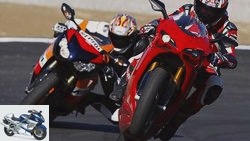
motorcycles
Traction control Ducati 1198S, C-ABS Honda Fireblade
Electronic control systems
read more
Measurements
Drawing: archive
Measurements of the BMW engine in different settings.
Compared to the other 1000s with 190/55 rear tires (Kawa-saki, Yamaha), the BMW has a significantly shorter gear ratio, compared to the Fireblade with flatter 190/50 tires only a little. First gear is relatively short. The two levels in the torque curve (at 5000 and 8000 rpm) are already at an impressively high level.
Measurements
Mileage:
Top speed (factory information) 299 km / h
acceleration
0-100 km / h 3.1 sec
0–140 km / h 4.5 sec
0–200 km / h 7.0 sec
Draft
60–100 km / h 3.4 sec
100–140 km / h 3.3 sec
140–180 km / h 3.3 sec
Speedometer deviation
Effective (display 50/100) 47/97 km / h
Tachometer deviation
Display red area 14000 rpm
Effective 14,000 rpm
Drawing: archive
Measurement of the transmission of the S 1000 RR.
Consumption:
at 130 km / h 6.1 l / 100 km
Country road 6.0 l / 100 km
Theor. Range of the country road 292 km
Fuel type super
Mass and weight:
L / W / H 2080/785/1110 mm
Seat height 810 mm
Handlebar height 860 mm
Turning circle 6800 mm
Weight with a full tank 208 kg
Payload 197 kg
Wheel load distribution v / h 52/48%
Driving dynamics
Handling course I (fast slalom)
The S 1000 RR waves very stable through the fast slalom. Only 0.2 sec. the S 1000 RR is behind the previous record of the very handy RSV4. At the speed at the measuring point, it can even beat the Aprilia.
| Lap time of the S 1000 RR | 19.3 sec. |
| Reference Aprilia RSV4 1000 Factory | 19.1 sec. |
| Vmax at the measuring point of the S 1000 RR | 120.9 km / h |
| Reference Aprilia RSV4 1000 Factory | 120.4 km / h |
Orbit diameter 46 meters
Drawing: archive
Measurement of the brakes of the S 1000 RR
The S 1000 RR lifts in sport mode rarely with the rear wheel, the control intervals can be clearly felt in the hand lever. At maximum deceleration, the hindquarters occasionally come off track. The slick mode enables an average deceleration of 9.7 m / s2, but then the rear wheel constantly lifts off. In extreme cases, it can lead to a forward rollover.
Brake measurement from 100 km / h
| Braking distance of the S 1000 RR | here residual speed- speed 27.8 km / h |
41.5 m |
| Reference Suzuki GSX-R1000 | 38.3 m |
Conclusion
Artist
At the end of a long day, it becomes clear that BMW’s super sports premiere was a success.
As a newcomer, the BMW S 1000 RR is right at the top of its class. No super sporty 1000 has managed to score over 700 points. The solid engine and chassis technology basis of the BMW should, however, be supplemented by the combination of ABS and DTC, which is subject to a surcharge. It is of great help when it comes to using the enormous performance sensibly.
Noticed
Plus:
- The ignition key fits into the heads of the adjusting screws on the fork and the low-speed compression stage of the shock absorber. Most of the damping functions can be quickly adapted to different circumstances.
- The on-board tool kit of the BMW almost ties in with old traditions. With the help of the nine-piece set, you can strip the motorcycle, tension the chain, replace defective lamps and fuses, and adjust the spring preload front and rear.
- The footrests are serrated so that the driver’s boots find a secure hold for all gymnastics exercises that are relevant to fast driving.
Minus:
- As is usual with super athletes, passengers will only find one emergency seat on the S 1000 RR. The only consolation: It could get worse.
- The steering damper is a bit difficult, the same applies to the gearshift and throttle grip.
Rating engine
Drawing: archive
Rating engine
BMW wanted to make a clear announcement for the new entry. That is done. Every driving dynamics rating sees them as one of the frontrunners or even right at the top. Especially when it comes to acceleration, the S 1000 is awesome. There is still a little need for improvement in terms of response and load change behavior and the ease of shifting.
Rating chassis
Drawing: archive
Rating chassis
With standard values for the steering head angle and caster, but a slightly longer wheelbase and series tires of sporty leadership quality, the BMW is on the stable side of the spectrum, without giving up more than one point in terms of maneuverability. In favor of uncompromising sportiness, it can even allow itself a loss of comfort due to its tight cushioning.
Evaluation of everyday life
Drawing: archive
Evaluation of everyday life
This section of the rating is traditionally not exactly the strong point of super athletes. BMW is no exception. At least it lights up the road properly when driving at night and does not abuse its driver with a seated position that is too tight on the handlebars. The processing quality is on the level of the best Japan 1000s, although the surfaces of the frame and parts of the swingarm are a little coarser.
Security rating
Drawing: archive
Security rating
Great delay, rustic control behavior: This is how the work of the so-called Race ABS from BMW can be briefly characterized. The S 1000 owes the low set-up torque when braking in no small part to its series tires.
Valuation costs
Drawing: archive
Valuation costs
The low inspection costs make up for some of the high fuel bills. However, it is more expensive to maintain. Two years of warranty plus mobility guarantee are not outstanding.
Overall rating 703 out of 1000 points:
Not a bad grade for a super athlete, because they tend to be expensive and, because of their uncompromising nature, they are usually not overworking point collectors.
Price-performance rating (top rating 1.0): 2.7
Manufacturer
Aprilia RSV4 1000 R
Four-cylinder 65-degree V-engine, 1000 cm³, 180 hp, 115 Nm, six-speed gearbox, chain, weight 212 kg, Vmax 290 km / h, consumption 7.8 liters
Price including additional costs: 15,500 euros
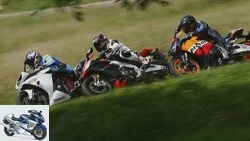
Super athlete
Aprilia RSV4 Factory, Honda Fireblade, Yamaha YZF-R1
A day in the country
read more
Manufacturer
Honda Fireblade C-ABS
Four-cylinder in-line engine, 1000 cm³, 178 hp, 112 Nm, six-speed gearbox, chain, weight 209 kg, Vmax 293 km / h, consumption 5.0 liters
Price including additional costs: 15990 euros
All used offers: Honda CBR 1000 RR Fireblade
Manufacturer
Kawasaki ZX-10R
Four-cylinder in-line engine, 998 cm³, 188 hp, 113 Nm, six-speed gearbox, chain, weight 210 kg, Vmax 298 km / h, consumption 5.7 liters
Price including additional costs: 14,775 euros
All used offers: Kawasaki Ninja ZX-10 R
Related articles
-
Kawasaki Ninja H2 in the top test
Bilski 26 pictures Bilski 1/26 Mi 218 hp, the H2 is the most powerful bike on the MOTORRAD test bench to date. Bilski 2/26 The polished stainless steel elbows form …
-
KTM 1290 Super Duke R in the top test
Jahn 29 pictures Jahn 1/29 Jahn 2/29 Impressive: the increase in torque at 6000 rpm. Jahn 3/29 Jahn 4/29 Mitterbauer 5/29 Edged game: The super …
-
Comparative test of athletes: BMW S 1000 RR against Honda Fireblade
13 Bilder Kunstle 1/13 The on-board tool kit of the BMW almost ties in with old traditions. With the help of the nine-piece set you can …
-
BMW, Yamaha and Kawasaki Powerbikes in the test
fact 17 pictures fact 1/17 Completely different concepts – with one thing in common: Apparently unlimited power. BMW S 1000 RR, Yamaha Vmax and Kawasaki …
-
BMW S 1000 R against KTM 1290 Super Duke R in the test
fact 31 pictures fact 1/31 With the BMW S 1000 R and the KTM 1290 Super Duke R, two of the hottest, most potent naked bikes meet here. fact …
-
Artist 20th photos Artist 1/20 The electronically adjustable ESA chassis, which now bears the suffix II, has also been modified. In addition to the…
-
Test: Aprilia RSV4 R and RSV4 Factory
Manufacturer Premiere: Aprilia RSV4 R and RSV4 Factory New surprises Content of The idea of competition sits deep in Aprilia’s soul, not just in…
-
Test of the Superbikes 2012 – The super athletes on the racetrack
Jahn 26th photos Jahn 1/26 The super athletes: Aprilia RSV4 Factory APRC, BMW S 1000 RR, Ducati 1199 Panigale S, Honda Fireblade, Kawasaki Ninja ZX-10R,…
-
Jahn Top test BMW K 1200 R Sport In the middle BMW is now placing the R Sport between the K 1200 S and R. The top test clarifies what the new,…
-
Honda VFR 800 F in the top test
25 pictures Montero 1/25 The cap pulls out gasoline by suction (negative pressure), it is opened when the tank is almost full or half full …